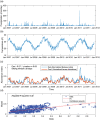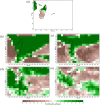The Mosquito, the Virus, the Climate: An Unforeseen Réunion in 2018
- PMID: 32864539
- PMCID: PMC7443513
- DOI: 10.1029/2020GH000253
The Mosquito, the Virus, the Climate: An Unforeseen Réunion in 2018
Abstract
The 2018 outbreak of dengue in the French overseas department of Réunion was unprecedented in size and spread across the island. This research focuses on the cause of the outbreak, asserting that climate played a large role in the proliferation of the Aedes albopictus mosquitoes, which transmitted the disease, and led to the dengue outbreak in early 2018. A stage-structured model was run using observed temperature and rainfall data to simulate the life cycle and abundance of the Ae. albopictus mosquito. Further, the model was forced with bias-corrected subseasonal forecasts to determine if the event could have been forecast up to 4 weeks in advance. With unseasonably warm temperatures remaining above 25°C, along with large tropical-cyclone-related rainfall events accumulating 10-15 mm per event, the modeled Ae. albopictus mosquito abundance did not decrease during the second half of 2017, contrary to the normal behavior, likely contributing to the large dengue outbreak in early 2018. Although subseasonal forecasts of rainfall for the December-January period in Réunion are skillful up to 4 weeks in advance, the outbreak could only have been forecast 2 weeks in advance, which along with seasonal forecast information could have provided enough time to enhance preparedness measures. Our research demonstrates the potential of using state-of-the-art subseasonal climate forecasts to produce actionable subseasonal dengue predictions. To the best of the authors' knowledge, this is the first time subseasonal forecasts have been used this way.
Keywords: Aedes albopictus; Réunion; dengue; outbreak; subseasonal forecast.
©2020. The Authors.
Conflict of interest statement
The authors declare no conflicts of interest relevant to this study.
Figures





Similar articles
-
Impact of regional climate change on the mosquito vector Aedes albopictus in a tropical island environment: La Réunion.Sci Total Environ. 2023 Jun 1;875:162484. doi: 10.1016/j.scitotenv.2023.162484. Epub 2023 Mar 6. Sci Total Environ. 2023. PMID: 36889019
-
High genetic diversity but no geographical structure of Aedes albopictus populations in Réunion Island.Parasit Vectors. 2019 Dec 19;12(1):597. doi: 10.1186/s13071-019-3840-x. Parasit Vectors. 2019. PMID: 31856896 Free PMC article.
-
Orally co-Infected Aedes albopictus from La Reunion Island, Indian Ocean, can deliver both dengue and chikungunya infectious viral particles in their saliva.PLoS Negl Trop Dis. 2010 Jun 8;4(6):e706. doi: 10.1371/journal.pntd.0000706. PLoS Negl Trop Dis. 2010. PMID: 20544013 Free PMC article.
-
[Aedes albopictus, vector of chikungunya and dengue viruses in Reunion Island: biology and control].Parasite. 2008 Mar;15(1):3-13. doi: 10.1051/parasite/2008151003. Parasite. 2008. PMID: 18416242 Review. French.
-
Strategic Approach, Advances, and Challenges in the Development and Application of the SIT for Area-Wide Control of Aedes albopictus Mosquitoes in Reunion Island.Insects. 2020 Nov 7;11(11):770. doi: 10.3390/insects11110770. Insects. 2020. PMID: 33171885 Free PMC article. Review.
Cited by
-
Aedes Aegypti-Insights on the Impact of Water Services.Geohealth. 2022 Nov 1;6(11):e2022GH000653. doi: 10.1029/2022GH000653. eCollection 2022 Nov. Geohealth. 2022. PMID: 36439027 Free PMC article.
-
Relationship between Climate Variables and Dengue Incidence in Argentina.Environ Health Perspect. 2023 May;131(5):57008. doi: 10.1289/EHP11616. Epub 2023 May 24. Environ Health Perspect. 2023. PMID: 37224070 Free PMC article.
-
Uncovering temperature sensitivity of West Nile virus transmission: Novel computational approaches to mosquito-pathogen trait responses.PLoS Comput Biol. 2025 Mar 31;21(3):e1012866. doi: 10.1371/journal.pcbi.1012866. eCollection 2025 Mar. PLoS Comput Biol. 2025. PMID: 40163523 Free PMC article.
-
Investigation of Dengue Infection in Asymptomatic Individuals during a Recent Outbreak in La Réunion.Viruses. 2023 Mar 14;15(3):742. doi: 10.3390/v15030742. Viruses. 2023. PMID: 36992451 Free PMC article.
-
The 2024 report of the Lancet Countdown on health and climate change: facing record-breaking threats from delayed action.Lancet. 2024 Nov 9;404(10465):1847-1896. doi: 10.1016/S0140-6736(24)01822-1. Epub 2024 Oct 30. Lancet. 2024. PMID: 39488222 Free PMC article. Review.
References
-
- Bhatt, S. , Gething, P. W. , Brady, O. J. , Messina, J. P. , Farlow, A. W. , Moyes, C. L. , Drake, J. M. , Brownstein, J. S. , Hoen, A. G. , Sankoh, O. , Myers, M. F. , George, D. B. , Jaenisch, T. , Wint, G. R. W. , Simmons, C. P. , Scott, T. W. , Farrar, J. J. , & Hay, S. I. (2013). The global distribution and burden of dengue. Nature, 496(7446), 504–507. 10.1038/nature12060 - DOI - PMC - PubMed
-
- Bouhet, R. (2018). Berguitta: levée de l'alerte cyclonique à La Réunion, recherche d'un "éventuel disparu". Europe1. Retrieved from https://la1ere.francetvinfo.fr/berguitta-levee-alerte-cyclonique-reunion...
LinkOut - more resources
Full Text Sources
